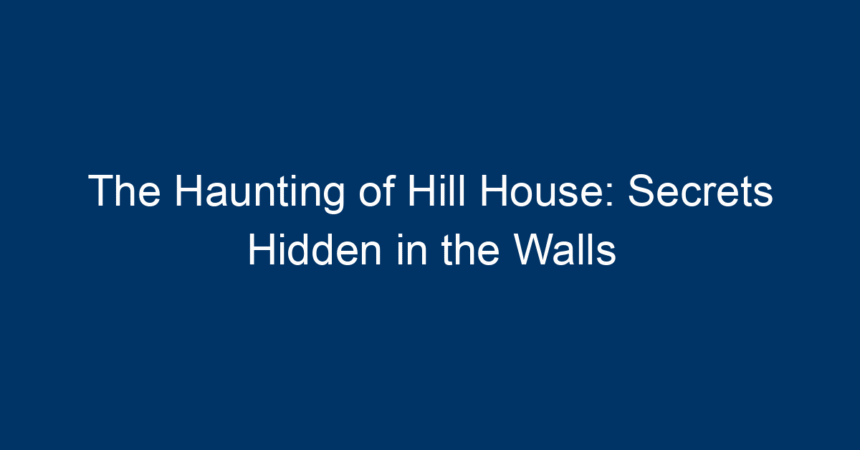Introduction
"The Haunting of Hill House," a beloved gothic horror tale penned by Shirley Jackson, has captivated readers and viewers alike since its release in 1959. The story intricately weaves together themes of family dysfunction, psychological dread, and the supernatural, all set against the backdrop of a house that seems to breathe its own life. Whether you are a long-time fan of the novel, the iconic film adaptations, or the acclaimed Netflix series, this article will delve deep into the mysteries and secrets hidden within the walls of Hill House.
A Glimpse into Hill House’s History
Hill House, as described in both the book and the series, is more than just a setting; it is a character in its own right. Jackson masterfully gives life to this imposing structure, portraying it as a sentient being that embodies the tragedies of the families who inhabit it. Originally built in the late 19th century by the wealthy Hugh Crain, the house is laden with hidden histories and untold secrets.
Architectural Mysteries
The architectural design of Hill House is pivotal to its haunting nature. With its odd angles and eerie corridors, the house’s layout seems almost deliberately disorienting. This design invites viewers to consider the unseen forces that may inhabit the space. The use of dark wood and expansive windows creates a feeling of isolation, amplifying the tension as characters navigate their inner fears.
The Characters: Weaving Personal Traumas into the Narrative
In "The Haunting of Hill House," each character represents different facets of trauma and grief. This section explores the main characters and how their personal secrets intertwine with the overarching narrative, leading to deeper connections with Hill House itself.
Eleanor Vance: The Fragile Dreamer
Eleanor Vance is perhaps the most tragic figure. Haunted by her past and seeking acceptance, she finds herself drawn to Hill House. The house amplifies her insecurities, ultimately leading her to dangerous paths. Through Eleanor’s eyes, readers experience the oppressive weight of unfulfilled desires and mental anguish, underscoring how personal trauma can manifest in physical spaces.
The Crain Family: Generational Pain
The Crain family, central to the Netflix adaptation, illustrates the repercussions of unresolved issues across generations. Each member grapples with their experiences within Hill House, revealing secrets that have lingered like dust in the corners. In particular, sibling relationships are strained, echoing themes of abandonment, jealousy, and the need for familial loyalty.
The Supernatural Elements: Are They Real or Just Psychological?
One of the compelling aspects of "The Haunting of Hill House" is the ambiguity surrounding its supernatural occurrences. Are the hauntings a product of the characters’ minds, or is Hill House truly a conduit for malevolent forces?
Ghosts of the Past
The concept of ghosts in Hill House transcends traditional portrayals of the supernatural. The house itself serves as a vessel for the characters’ past traumas and hidden regrets. Each apparition they encounter acts as a reflection of their inner demons, blurring the lines between psychological horror and true supernatural phenomena.
The Role of the Narrator
In both the novel and the series, the narrative viewpoint plays a crucial role in determining how we interpret the hauntings. With unreliable narrators and fragmented storytelling, readers are left to piece together the truth. This innovative approach heightens the suspense and draws us further into the eerie atmosphere of Hill House.
Symbolism: What Hill House Represents
The symbolism of Hill House extends far beyond its walls. It represents not just a physical space but also the haunting memories and traumas of the characters that live within it.
The House as a Metaphor for Mental Illness
Hill House serves as a powerful metaphor for mental illness. It traps its inhabitants within cycles of despair and irrational fears. The manifestation of supernatural occurrences may reflect the characters’ psychological states, presenting a critique of how society views mental health struggles.
Aspects of Feminine Anxiety
Another layer of symbolism in "The Haunting of Hill House" relates to the experiences of women, especially Eleanor Vance. Her journey symbolizes the struggle for autonomy and identity in a patriarchal society. The house holds both the promise of freedom and the chains of societal expectations, mirroring the complexities of womanhood.
Analyzing the Adaptations: Variations in Interpretation
"The Haunting of Hill House" has seen multiple adaptations, each offering a unique interpretation of the source material. These adaptations not only bring new life to Jackson’s classic but also uncover additional layers to its meaning.
The Netflix Series: A Modern Retelling
The 2018 Netflix series expands the narrative, delving deeper into the intricacies of family dynamics. It presents modern audiences with a multi-dimensional view of the Crain family while highlighting issues of grief, trauma, and addiction. The series employs innovative storytelling methods, such as non-linear timelines, to engage viewers.
Classic Film Interpretations
Previous adaptations, including the 1963 film, focus more heavily on the horror elements while deviating from the psychological undercurrents of the novel. These films provide thrilling scares but often miss the nuanced exploration of character development that makes Jackson’s work so compelling.
Conclusion: Unraveling the Secrets Within
"The Haunting of Hill House" is much more than a ghost story; it invites readers and viewers alike to confront their fears, the secrets held within families, and the scars that shape their identities. Whether through the lens of psychological horror or supernatural elements, the themes resonate on a profound level.
Actionable Insights
To experience the full impact of "The Haunting of Hill House," consider the following:
-
Read the Novel: Immerse yourself in Shirley Jackson’s original work to appreciate its depth and subtlety.
-
Watch Different Adaptations: Explore various film and TV adaptations to see how interpretations differ in presenting key themes.
-
Reflect on Personal Traumas: Think about how your own experiences may shape your perception of fear and family. Discussing these themes can foster deeper understanding and healing.
- Join a Discussion Group: Engage in conversations about the book or series, allowing diverse perspectives to enrich your viewing or reading experience.
In conclusion, "The Haunting of Hill House" continues to mesmerize and terrify, illuminating the haunting nature of secrets hidden in the walls of our psyches and the spaces we inhabit. Keep exploring the shadows, as therein lies the unsettling truth.




